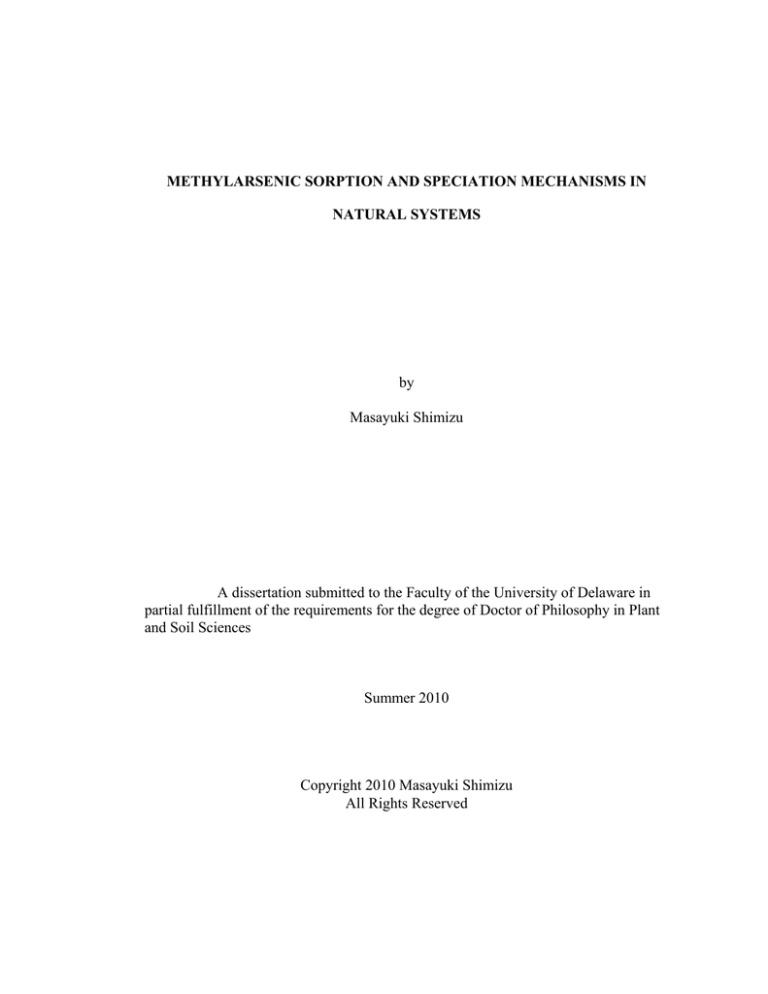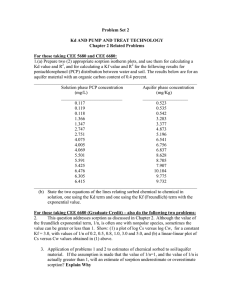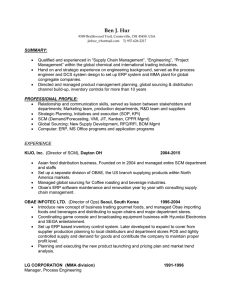
METHYLARSENIC SORPTION AND SPECIATION MECHANISMS IN
NATURAL SYSTEMS
by
Masayuki Shimizu
A dissertation submitted to the Faculty of the University of Delaware in
partial fulfillment of the requirements for the degree of Doctor of Philosophy in Plant
and Soil Sciences
Summer 2010
Copyright 2010 Masayuki Shimizu
All Rights Reserved
ABSTRACT
Arsenic (As) originates in many rocks and minerals throughout the world.
Natural phenomena, such as weathering and biological activities, along with industrial
activities and agricultural activities are responsible for As introduction to the
environment. The most predominate oxidation states for inorganic As species are
arsenate AsV (H3AsO4) and arsenite AsIII (H3AsO3). In addition to inorganic forms,
organic forms of As also exist in nature, typically occurring in terrestrial environments
as monomethylarsenate, MMA (CH3H2AsO3) and dimethylarsenate, DMA
((CH3)2HAsO2). MMA and DMA have historically been used as herbicides and
pesticides. Because of their large application to agricultural fields and the toxicity of
MMA and DMA, the behavior of methylarsenics in the soil environment requires
investigation. Accordingly, the objectives of this study were 1) characterize MMA and
DMA sorption to aluminum oxide, 2) characterize MMA and DMA sorption,
speciation, and distribution to a soil, and 3) characterize MMA and DMA sorption and
desorption to various types of soils.
MMA and DMA sorption on amorphous aluminum oxide (AAO) were
investigated using both macroscopic batch sorption kinetics and molecular scale
Extended X-ray Absorption Fine Structure (EXAFS) and Fourier Transform infrared
(FTIR) spectroscopic techniques. Sorption isotherm studies revealed sorption maxima
of 0.183, 0.145, and 0.056 mmol As / mmol Al for arsenate (AsV), MMA, and DMA,
respectively. In the sorption kinetics studies, 100 % of added AsV was sorbed within 5
min, while 78 % and 15 % of added MMA and DMA were sorbed, respectively.
xi
Desorption experiments, using phosphate as a desorbing agent, resulted in 30 %
release of absorbed AsV, while 48 % and 62 % of absorbed MMA and DMA,
respectively, were released. FTIR and EXAFS studies revealed that MMA and DMA
formed mainly bidentate binuclear complexes with AAO. Based on these results, it is
proposed that increasing methyl group substitution results in decreased As sorption
and increased As desorption on AAO.
The distribution, speciation, and sorption of MMA and DMA to soils were
also investigated. MMA and DMA were reacted with the Reybold soil (Typic
Hapludults) for up to 1 year under aerobic and anaerobic conditions. Micro
synchrotron X-ray fluorescence (µ-SXRF) mapping studies showed that MMA and
DMA were heterogeneously distributed in the soil, and were mainly associated with
the iron oxides, goethite and ferrihydrite, in the soil. Micro X-ray absorption near edge
structure (µ-XANES) spectra collected from As hotspots showed MMA and DMA
were demethylated to AsV over 1 year of incubation period under aerobic conditions.
MMA was methylated to DMA which persisted over 3 months of incubation period
under anaerobic conditions. Under both redox conditions, arsenic-iron precipitation,
such as the formation of scorodite (FeAsO4·2H2O), was not observed, indicating that
MMA and DMA were associated with iron oxides as sorption complexes. Our results
suggest that redox potential is one of the factors that influence As speciation in the
environment.
MMA and DMA sorption and desorption were investigated in soils,
varying in mineralogical and organic matter contents. Sorption studies showed that
Al/Fe-oxides were the main sorbents in the soils, and the sorption capacity increased
as Al/Fe concentration in the soils increased. MMA sorption was greater than DMA
xii
sorption, and the rate of MMA sorption was also faster than DMA sorption rate. Other
potential sorbents, such as clay minerals, quartz, and organic matter did not affect
MMA and DMA sorption as much as Al/Fe content did. EXAFS studies showed that
both MMA/DMA-Fe interatomic distances were around 3.3 Å, which was indicative
of inner-sphere complex formation, particularly bidentate binuclear complex
formation. Desorption studies showed that not all of the sorbed MMA or DMA was
desorbed due to the strong binding between MMA and DMA and iron oxides in the
surface via inner-sphere complex formation. The amount of the desorbed MMA and
DMA decreased as the sorption residence time increased. For example, 77 % of
sorbed MMA was desorbed from the Reybold sub soil after 1 day residence time, and
66 % of sorbed MMA were desorbed from the same soil after 6 months of residence
time. The decreases in the desorption was likely due to As speciation changes over
time. As residence time increased more MMA was demethylated to AsV which was
more strongly bound to the surface. This study highlights that MMA and DMA
behavior is not only determined by sorption/desorption but also by
methylation/demethylation processes. The persistency of these compounds in the
environment was longer than was previously expected.
xiii








